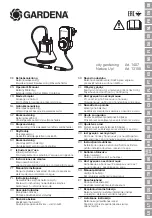
Safety
Landmark™ Test System Operation
17
components that contain pressurized gas. When you bleed a gas or remove a fitting, hose, or
component that contains a gas, remember that many gases cannot support life. Therefore, as
the ratio of released gas to oxygen increases, so does the potential for suffocation.
l
Wear appropriate safety devices to protect your hearing. Escaping air or gas can create a
noise level that can damage your hearing.
l
Ensure that all pressurized air or gas is bled out of a pneumatic or gas-charged device before
you start to disassemble it. A thorough understanding of the assembly and its pressurized
areas is necessary before you undertake any maintenance. Refer to the appropriate product
information for the correct bleeding procedure.
It may not be obvious or intuitive which bolts or fittings are used to restrain a pressurized area.
On some assemblies, you must remove a cover plate to gain access to the structural bolts.
Sometimes, to protect you from a rapid release of trapped gases, a small port is exposed
when you remove this cover plate. Exposing this port ensures that the gas precharge is fully
bled before disassembly. However, this is not the recommended procedure for bleeding a
pneumatic or gas-charged device, because it can expose you to the dangers of escaping
compressed gas and particulates that are expelled from the chamber or around the seals. Do
not assume that cover plates and ports are installed in all the critical locations.
Consult MTS when in doubt about the safety or reliability of any system-related procedure or
modification that involves devices that contain any type of compressed gas.
Check bolt ratings and torques
To ensure a reliable product, fasteners (such as bolts and tie rods) used in MTS-manufactured
systems are torqued to specific requirements. If a fastener is loosened or the configuration of a
component within the system is modified, see the system and component assembly drawings (located
on the System Documentation CD) to determine the correct fastener, fastener rating, and torque. Over
torquing or under torquing a fastener can create a hazardous situation due to the high forces and
pressures present in MTS test systems.
On rare occasions, a fastener can fail even when it is correctly installed. Failure usually occurs during
torquing, but it can occur several days later. Failure of a fastener can result in a high velocity projectile.
Therefore, it is a good practice to avoid stationing personnel in line with or below assemblies that
contain large or long fasteners.
Practice good housekeeping
Keep the floors in the work area clean. Industrial chemicals, such as hydraulic fluid, that are spilled on
any type of floor can result in a dangerous, slippery surface. Do not leave tools, fixtures, or other items
not specific to the test lying about on the floor, system, or decking.
Protect hoses and cables
Protect electrical cables from spilled fluids and from excessive temperatures that can cause the cables
to harden and eventually fail. Ensure that all cables have appropriate strain relief devices installed at
the cable and near the connector plug. Do not use the connector plug as a strain relief.
Summary of Contents for Landmark 370 Series
Page 39: ...System Introduction Landmark Test System Operation 39...
Page 40: ......
Page 114: ......
Page 122: ......
Page 123: ...Decommissioning Landmark Test System Operation 123 Decommissioning Decommission 124...
Page 132: ......
Page 133: ......
















































